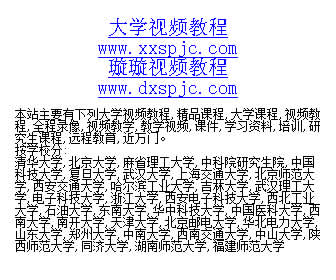中文名称:Keystone CSharp视频教程
英文名称:KeyStone Programing with Microsoft C#
资源类型:Bin
发行时间:2004年
地区:美国
语言:英语
简介:
视频类型:rm
![《Keystone CSharp视频教程》(KeyStone Programing with Microsoft C#)[Bin]](http://pic.dxspjc.com/dx_pic/2005082904/20050829042433268.jpg)
KeyStone教程是一个系列的视频教程。这里发布的是KeyStone的C#视频教程。共5CD,安装后使用。
语速中等偏快,E文不佳的朋友不用下了。
目录如下:
C# Level 1
1. .NET Concepts
1.1 What is .NET
1.2 Introducing the .NET Framework
1.3 Understanding the Common Type Systems
1.4 Compilers, Assemblies & Microsoft Intermediate Language
1.5 Namespaces
2. Using the Visual Studio .NET IDE
2.1 Introducing the IDE
2.2 Compiling
2.3 Debugging
2.4 Database Manipulation Tools
2.5 Getting Help
3. Language Fundamentals
3.1 Comments
3.2 Types
3.3 Creating Variables & Constants Using Value Types
3.4 Basic Expressions & Operators
3.5 Casting & Conversion
3.6 Building Enumerations
3.7 Control of Flow
C# Level 2
1. Working with Classes & Objects
1.1 Class Basics
1.2 Creating Methods
1.3 Using Data Members
1.4 Instance vs. Static Members
1.5 Creating Variables Using Reference Types
1.6 Boxing & Unboxing
1.7 Constructors
1.8 Destructors
1.9 Encapsulation
1.10 Garbage Collector
2. Using Strings
2.1 String Concepts
2.2 Creating Strings
2.3 Important String Methods
2.4 Using the String Builder Class
3. Inheritance
3.1 Inheritance Concepts
3.2 Basic Syntax
3.3 Inheritance & Access Modifiers
3.4 Constructor Chaining
3.5 Using Virtual Methods
3.6 Sealing a Class
3.7 Abstract Classes
C# Level 3
1. Using Arrays
1.1 Array Concepts
1.2 Declaring Arrays
1.3 Important Array Methods
1.4 Multidimensional Arrays
2. Polymorphism
2.1 Polymorphism Concepts
2.2 Polymorphism & Inheritance
3.0 Structs
3.1 Struct Concepts
3.2 Defining Structs
3.3 Using Structs
3. Interfaces
4.1 Interface Concepts
4.2 Creating an Interface
4.3 Implementing & Interface
4.4 Using the Idispose Interface
4.5 Casting to Interface Types
4. Collections
5.1 Collection Concepts
5.2 Collection Interfaces
5.3 Using Array Lists
5.4 Using Queues
5.5 Using Stacks
5.6 Using Hashtables
6.0 Putting It All Together
6.1 The Scenario
6.2 The Solution
C# Level 4
1. Handling Exceptions
1.1 Introduction to Exceptions
1.2 Exception Classes
1.3 Using Try, Catch & Finally
1.4 Catching Multiple Exceptions
1.5 Throwing Standard Exceptions
1.6 Throwing Custom Exceptions
2. Operator Overloading
2.1 Operator Overloading Concepts
2.2 Overloading Mathematical Operators
2.3 Overloading Comparison Operators
2.4 Overloading Conversion Operators
3. System IO Namespace
3.1 IO Concepts
3.2 Working with Files & Directories
3.3 Stream Objects
3.4 Readers & Writers
3.5 Network IO
3.6 Object Serialization
4. Using Web Streams
4.1 Using the Basic Model
4.2 Creating a Client Application
4.3 Security
C# Level 5
1. Delegates & Events
1.1 Delegates Explained
1.2 Callbacks & Delegates
1.3 Multicast Delegates
1.4 Using Events
2. Threading
2.1 Threading Concepts
2.2 Thread Basics
2.3 Thread Synchronization
3. Deployment
3.1 Assembly Concepts
3.2 Creating Assemblies
4. Reflection & Attribute Programming
4.1 Intrinsic Attributes
4.2 Custom Attributes
4.3 Reflection Concepts
4.4 Viewing Metadata
4.5 Extracting Type Information
4.6 Dynamic Invocation

